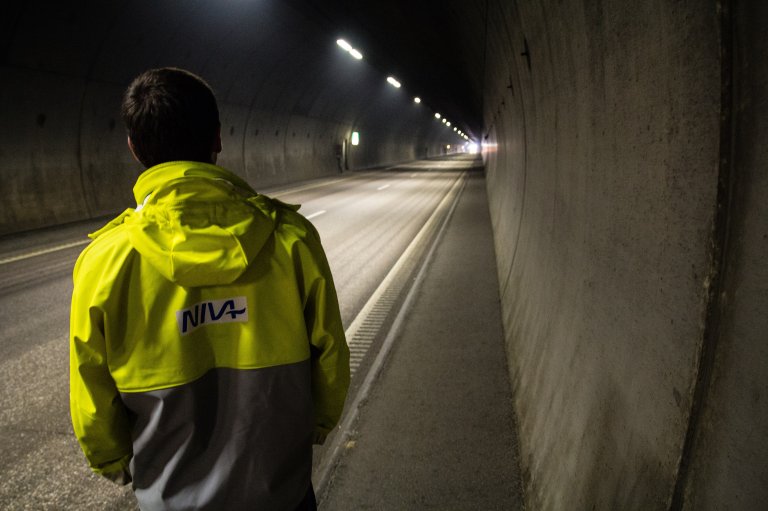
Chemicals are leaching from Norwegian roads and tunnels
A road is not only a road. It also consists of bridges, tunnels and technical installations, that must be built, drilled and blasted, cemented, paved, painted and maintained. The dich vegetation should be maintained, the tunnels must be swept and washed several times during a year, the vehicles need fuel, oil and brake fluid, and treatment with car care products. The use of chemicals is involved at all levels, either directly or as an additive in various materials and equipment. Researchers from The Norwegian Institute for Water Research (NIVA), The Norwegian University of Life Sciences (NMBU), The Norwegian Public Roads Administration and Oregon State University have investigated the amounts of hazardous chemicals in use in products related to motorized transport in Norway, analyzed the levels of toxicants in road dust and investigated how available the toxicants are for uptake in biota.
280 tons of chemicals
When talking about road traffic and environmental consequences, attention is often paid to greenhouse gas emissions, air pollution and noise pollution. People are usually not as aware of heavy metals, salts, and organic pollutants originating from the traffic.
- There is a general knowledge gap regarding which chemicals are present in various transport related products, and how big amounts we are talking about, says Sondre Meland, researcher at NIVA.
- The current knowledge about how these chemicals spread in the environment is also insufficient. This is what we investigated in these studies.
The Norwegian Environmental Agency lists the 33 most concerning chemicals for health and environment in the so-called Priority List. These chemicals may cause cancer, reproduction failures, or heritable changes in the genes of human and wildlife. The chemicals are only slowly degraded in nature, and consequently build up in the food chain. Meland and his colleagues did a data register study, and found that in 2012, 280 tons of Priority List chemicals related to road construction, motorized transport and car care were in use. These substances may leak out to the environment and affect plants and wildlife.
Which chemicals end up in the road dust?
The researchers collected road dust from a road-sweeping vehicle and water samples from tunnel-wash waters in the Nordby tunnel in Oslo. They also collected several other samples from water and sediments that were impacted by road traffic in the Oslo area. The samples were brought to the laboratory, and analyzed for chemical content.
- The compounds in the road dust from the Nordby tunnel was strongly dominated by residues from incomplete fuel combustion, explains Sissel Ranneklev, researcher at NIVA.
Such compounds are called polycyclic organic hydrocarbons (PAHs), and are known for being carcinogenic. There were 50 different PAHs detected in the road dust, of which only five are regularly monitored by the authorities. They also detected other types of compounds, originating from plastics and other materials. Such compounds are typically used as additives, providing the materials specific traits like being fire retardant.

Tunnel wash with soap
Particle- associated compounds must be detached from its particle to have a biological effect. When detached, the compound is available for uptake in small organisms, and may enter the food web. Ranneklev and her colleagues analyzed the availability of road dust compounds and investigated whether addition of soap, or detergents, influenced the availability.
- The use of detergents increased the availability of big and heavy compounds. Consequently, tunnel wash using detergents may increase the toxicity of the wash water, Ranneklev says.
In most cases tunnel wash waters is discharged directly into the environment.
>> Further reading: Wildlife in the ditches need a detox cure
Need alternatives to toxic substances
The Norwegian Ministry of Transport and Communication states in the new National Transport Plan 2018-2029, that the investments in infrastructure will increase markedly in the years to come. Globally, the car production is expected to increase by 25 % within the next seven years, and the use of car care products in Norway in 2013 was more than five times higher than in 2002. The pollution from roads and transport related products will undoubtedly continue to increase. The researchers from NIVA, NMBU and The Norwegian Public Roads Administration made a list of hazardous substances of which more than 1 ton is in annual use in Norway. The ten most important compounds were methyl-tert-butylether (MTBE), benzene, tetrachloroethylene, hydrazine, medium chain paraffins, tetraborates, nonylphenols, the siloxane D5, and orange lead.
- We hope this list will help the environmental authorities prioritizing substances for monitoring and phasing out. Alternative compounds already exist for several substances on the list, Sondre Meland concludes.